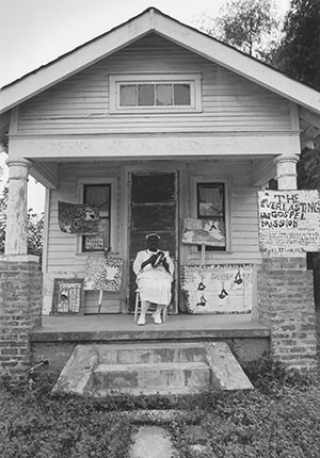Born 1900, LaFayette, Alabama
Died 1980, New Orleans, Louisiana
By the time Sister Gertrude Morgan was making pictures regularly in the early 1960s, she had already spent nearly twenty years as a Holiness-Pentecostal missionary and street preacher. Drawings such as A POEM OF MY CALLING tell the personal side of this vocation through Morgan’s handwritten texts. Her religious path began in 1934 when she heard God call her to evangelize, prompting her to leave her home—Columbus, Georgia, at the time—and to settle in New Orleans in 1939. Other artworks also allude to a 1957 revelation that declared her the Bride of Christ, a joyous transformation that signified Morgan’s spiritual union with her “Redeemer” and a moment she marked by adopting all-white clothing.
Though visual art is unusual within Pentecostal expressive practices and Morgan lacked formal training in art, her works communicate ecstatic themes in the improvisational and musical style characteristic of this faith tradition. Revelation 7. chap depicts John the Apostle’s apocalyptic vision from the New Testament in which angels orchestrate steps in divine plans for the end of history, buoyed by Morgan’s transcription of biblical verses. In come on. come in my Room, come on in the Prayer Room lyrics from a traditional gospel song frame the scene below as a sacred space. This interior resembles Morgan’s house-based church, complete with white-washed walls, renditions of her paintings, and a self-portrait calling a service to order. Yet the picture is more than mere representation: phrases such as “he that Readeth . . . the words of this prophecy” and instructions to “sing” make the artwork an active tool of evangelism. In Morgan’s art, viewers are addressed as participants in an unfolding spiritual journey.
Larry Borenstein, an art dealer in New Orleans’s French Quarter, displayed and sold Morgan’s work during her lifetime. Such exposure put her in contact with some of the most active collectors of self-taught art in the 1970s and ensured her inclusion in nationally touring exhibitions, the most significant of which was arguably Black Folk Art in America, 1930–1980. Organized by the Corcoran Gallery of Art in 1982, it framed untrained African American artists within a modernist paradigm, intensifying art historical and anthropological debates over whether their production should be classified as art or cultural artifact.
Elaine Yau
Fagaly, William A. Tools of Her Ministry: The Art of Sister Gertrude Morgan. New York: American Folk Art Museum, with Rizzoli International, 2004.
Yau, Elaine Y. “Acts of Conversion: Sanctification and the Sense of Race in the Art of Sister Gertrude Morgan.” In Sensational Religion: Sensory Cultures in Material Practice. Ed. Sally M. Promey. New Haven: Yale University Press, 2014.
